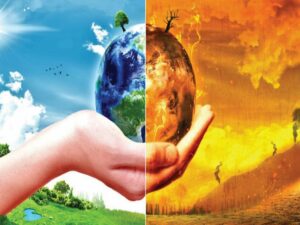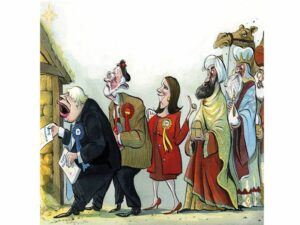Current policies are failing; social transformation is necessary to give us a fighting chance of success
Achieving net zero by 2050 has become a beacon climate action revolves around. Each country that agreed to the Paris Agreement has submitted Nationally Determined Contributions (NDCs) to the UNFCCC, laying out their plans to reduce emissions. The NDCs allow the UNFCCC to determine whether the world is on course to reach net-zero by 2050. Based on current NDCs we’re way off the mark, with the world on track for 2.7 °C warming by 2100. And that’s a best-case scenario. The NDCs fall woefully short of the 2°C limit the IPCC has set as an upper threshold that must not be exceeded to avoid catastrophic environmental changes.
We are knowingly continuing on a path leading to failure. It seems incomprehensible when the fate of humanity is at risk. And yet we’re hurtling towards failure because the underlying causes of the climate crisis remain unquestioned. What’s required is a radical rethink of how we do things. Considering failure isn’t an option, here are three radical policy changes that would give us a fighting chance of success.
1. Move away from a growth economy
The economy is designed to grow; the idea it could do anything else isn’t contemplated. When the economy shrinks, it leads to recession and crises.
In Beyond Growth, the economist Herman Daly argues sustainable development “means a radical shift from a growth economy and all it entails to a steady state economy.” (Herman Daly. 1996. Beyond Growth: Economics of Sustainable Development, p. 31
A steady state economy (SSE) is an economy:
“that aims to maintain a stable level of resource consumption and a stable population. It’s an economy in which material and energy use are kept within ecological limits, and in which the goal of increasing GDP is replaced by the goal of improving quality of life.” (Rob, Dietz and Dan O’Neill. 2013. Enough is enough, p. 45)
Unlike a growth economy, which requires ever-increasing throughputs of energy and materials to increase production and consumable goods, in an SSE, the throughput of energy and materials remains constant. The idea is that a dynamic equilibrium is maintained just like the Earth. The Earth isn’t static and unchanging but maintains an energy balance that can continue indefinitely if an outside force doesn’t influence the processes that maintain stable environmental conditions.
Moving away from growth as the foundational goal of economic activity has profound implications, none more so than on how money is created.
2. Move towards an interest-free money system
Contrary to public opinion, central banks don’t print the vast majority of the money supply. In the UK, The Bank of England and the Royal Mint only create about 3 per cent of the money supply as banknotes and coins. The rest is ‘created’ by commercial banks, almost literally out of nothing, in the form of interest-bearing loans.
When a bank loans money at interest, clearly, they expect to be paid back. The economist Richard Douthwaite suggests the;
“fundamental problem with the debt method of creating money is that, because interest has to be paid on almost all of it, the economy must grow continuously if it is not to collapse.” (Douthwaite, R. 1999. The Ecology of Money, p. 24)
Debt creates a growth imperative, which is why companies operating in competitive markets must maximise profits. The economy must keep growing because debt can only be paid back at interest if the economy continues to expand.
But seeing as a growing economy is by design unsustainable, so long as money is created as a form of debt, the money system will compel more growth, which means more energy inputs and further emissions.
The only viable solution is to return to an interest-free banking system. As Herman Daly puts it;
“One hundred percent reserves would put our money supply back under the control of the government rather than the private banking sector. Money would be a true public utility, rather than the by-product of commercial lending and borrowing in pursuit of growth.” (Daly, Herman. 2008. “A steady state economy.” Sustainable Development Commission)
For powerful vested interests, such a solution is unthinkable and one they will never accept because they will lose all of their power and influence if they did.
3. Change how social success is measured
Gross Domestic Product (GDP) remains the perfect success metric used to measure the health of an economy because it’s designed to measure whether an economy has grown. And as economic growth remains unquestioned, the metric used to measure economic growth also goes unquestioned.
But GDP doesn’t measure whether well-being or happiness have increased or poverty levels have decreased. Whether more people are in debt because they can’t afford to pay their bills, whether the amount of people using food banks is rising. Whether homelessness is increasing, the list goes on.
The problem with GDP was made famous by Robert Kennedy, who said GDP “measures everything…except that which makes life worthwhile.”
If people’s happiness isn’t your ultimate goal, then it is a massive assumption to assume more economic growth will lead to social prosperity. It certainly has not achieved that so far, so why would we assume the outcomes will be any different with more growth? Compounding the issue, GDP says nothing about the environmental impacts of growth; it says nothing about whether growth comes at the cost of increasing emissions, or destruction of habitats, or the extinction of wildlife.
The environmental consequences are decoupled from growth, so how can we be sure increasing social prosperity doesn’t come at the cost of environmental damage?
If we had a set of indicators that embedded the effects of human activities on the climate, environment and society, success would look very different. But as the impacts of increasing GDP aren’t measured, the connection between economic growth and increased environmental impacts isn’t recognised.
In 2008 the French president Nicholas Sarkozy, so unsatisfied with GDP as a measurement of social success, that he created the Commission on the Measurement of Economic Performance and Social Progress to come up with an alternative. That commission led to the publication of Beyond Growth: Measuring What Counts for Economic and Social Performance. In it, the authors highlight why GDP is not fit for purpose and suggest how we can measure social well-being within ecological limits.
There is a mountain of sources focused on moving away from GDP and towards metrics focusing on human well-being. If even presidents of nations question its use, it seems almost laughably simple to solve the issues created by GDP — just change the metric. It has, after all, only been used since 1940. But it’s not as simple as that — the goal of the economy has not changed, so what’s the incentive to change the metric used to measure growth? No matter how much evidence shows its glaring flaws, and alternatives that could profoundly shift behaviour and motivations, GDP will continue being used to measure success because it does the job it’s designed to do so well.
4. The economy works for the few, not the whole
Economic growth, GDP and creating money at interest exist are inextricably connected. If you change one, you must change them all. It’s these three key components of the economy that lie at the heart of why the climate crisis continues to get worse. They seep into every aspect of our daily lives and come to define human motivations, behaviour and opinions.
But economic growth (and its brothers in arms) will continue to go unquestioned because, as the ecosocialist Murray Bookchin puts it, “capitalism can no more be persuaded to limit growth than a human being can be persuaded to stop breathing.” It is growth that provides the system oxygen. That oxygen keeps the heart pumping; it flows through the arteries of the body, influencing and sustaining the health of every element. It’s not that capitalism can’t be persuaded to limit growth; it simply can’t do so without collapsing in on itself.
Moving away from growth has profound implications. It would involve the redesign of the economy and, with it, society. It has to be noted that clearly, more economic growth isn’t leading to better lives for the majority of people. And there are still hundreds of millions of people that live in chronic poverty. The argument is that more growth is needed to uplift them from poverty, but the issue isn’t that there’s not enough wealth; the issue is that wealth isn’t being distributed.
Rampant inequality within and between countries has created a system of haves and have-nots. The haves are the winners in society, a tiny minority who gain a disproportionate amount of the wealth generated by economic growth. The have nots, meanwhile, fight over the scraps.
The rich elite gains their power and influence from things remaining as they are, and they will do all they can to make sure the status quo is maintained. Their wealth and power mean more to them than the existential threat the climate crisis poses to humanity. And so it’s unrealistic to imagine they would voluntarily allow the implementation of a radical set of policies that will help transform society and allow us to create an economy that works within environmental limits.
The only way to catalyse change is from the bottom up. As we progress into the twenty-first century, what’s certain is the impacts of the climate crisis are going to become far more aggressive. As it gets warmer and drier, droughts will become more severe, leading to wide-scale crop failures. With crop failures come food shortages and increasing prices. It’s then that the system as it is will begin to be questioned by the masses because when people are hungry, they riot. When people are hungry, law and order will break down and calls for radical change will increase. Before that happens, things are going to have to get a whole lot worse for people to wake up to the reality we’re facing.



